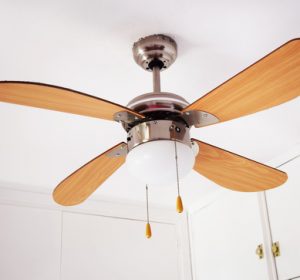 Ceiling fans are a versatile and cost-effective addition to any home. They not only provide comfort by improving air circulation and cooling but also contribute to energy savings. Choosing the best ceiling fan for your home involves considerations beyond aesthetics. In this blog post, we will guide you through the essential factors to consider when selecting the perfect ceiling fan for your space.
Ceiling fans are a versatile and cost-effective addition to any home. They not only provide comfort by improving air circulation and cooling but also contribute to energy savings. Choosing the best ceiling fan for your home involves considerations beyond aesthetics. In this blog post, we will guide you through the essential factors to consider when selecting the perfect ceiling fan for your space.
1. Determine the Room Size
The first step in choosing a ceiling fan is to determine the size of the room where it will be installed. The size of the room will help you select the appropriate fan size to ensure optimal air circulation. Here’s a general guideline:
- For rooms up to 75 square feet, choose a fan with a blade span of 29 to 36 inches.
- For rooms between 76 and 144 square feet, opt for a fan with a blade span of 36 to 42 inches.
- For rooms from 144 to 225 square feet, a fan with a blade span of 44 to 52 inches is suitable.
- For larger rooms over 225 square feet, consider fans with a blade span of 52 inches or more.
2. Ceiling Height Matters
The height of your ceiling will also impact the selection of your ceiling fan. Ceiling fans should be installed at the appropriate height to maximize their efficiency and safety. Here’s a general guideline:
- For standard ceilings with a height of 8 to 9 feet, a flush-mount ceiling fan is appropriate.
- For higher ceilings, you can use a downrod to lower the fan to the ideal height, ensuring efficient air circulation.
3. Consider the Blade Pitch
The blade pitch, or the angle of the fan blades, plays a significant role in a fan’s performance. Fans with steeper blade pitches tend to move air more effectively but may require more powerful motors. Look for a blade pitch between 12 to 15 degrees for optimal airflow.
4. Motor Quality Matters
The motor is the heart of any ceiling fan, and its quality directly impacts the fan’s performance and longevity. When selecting a ceiling fan, consider the following:
- Motor Type: There are two primary motor types: AC motors and DC motors. DC motors are more energy-efficient and quieter, making them an excellent choice for modern fans.
- Motor Size: Larger and more powerful motors tend to be more reliable and efficient. Look for fans with heavy-duty, high-performance motors.
5. Energy Efficiency and Labels
Choosing an energy-efficient ceiling fan can lead to substantial long-term savings on your energy bills. Look for fans with the ENERGY STAR label, which means they meet stringent energy efficiency guidelines. ENERGY STAR ceiling fans are up to 60% more efficient than standard fans.
6. Fan Control Options
Ceiling fans come with various control options to suit your preferences:
- Wall Control: Wall-mounted controls are convenient and typically come with multiple speed settings and light dimmers.
- Remote Control: Remote controls allow you to adjust the fan speed and lighting from anywhere in the room. Some also come with programmable features.
- Pull Chains: Traditional pull chains are a simple way to control your fan, but they may be less convenient.
7. Lighting Features
Many ceiling fans come equipped with built-in lighting, making them dual-purpose fixtures. Consider the type of lighting you need in your space, such as LED or incandescent bulbs, and whether you want a fan with a light kit.
8. Style and Aesthetics
Ceiling fans come in a wide range of styles and finishes to match your home’s decor. Whether you prefer a traditional, modern, or rustic look, you can find a fan that complements your design. Keep in mind that the fan’s blades and overall design will impact the aesthetic appeal of your room.
9. Noise Levels
The noise generated by a ceiling fan can vary. While some people enjoy the gentle hum of a fan, others prefer a virtually silent operation. If noise is a concern, consider reading reviews and looking for fans with quieter motors.
10. Installation and Maintenance
Ceiling fan installation should be carried out by a professional electrician to ensure safety and proper operation. Additionally, choose a fan that is easy to clean and maintain, with accessible motor housings and removable blades for hassle-free upkeep.
11. Outdoor vs. Indoor Ceiling Fans
If you plan to install a ceiling fan in an outdoor space, like a porch or a patio, make sure to choose a fan specifically designed for outdoor use. Outdoor fans are built to withstand moisture and the elements.
12. Warranty and Durability
A ceiling fan is a long-term investment, and it’s important to select a fan with a reliable warranty and durable construction. Look for fans with at least a 1-year warranty and consider extended warranties for added peace of mind.
13. Budget Considerations
Ceiling fans come in a wide range of price points. Set a budget that aligns with your preferences and needs. While high-end fans may offer advanced features and quality, there are many budget-friendly options that provide excellent value.
Summary
Selecting the best ceiling fan for your home involves several key considerations, from the room size and ceiling height to motor quality, energy efficiency, and control options. The right ceiling fan will not only enhance your comfort and energy savings but also complement your home’s aesthetics. By taking these factors into account, you can make an informed choice and enjoy the benefits of a well-chosen ceiling fan in your living spaces.